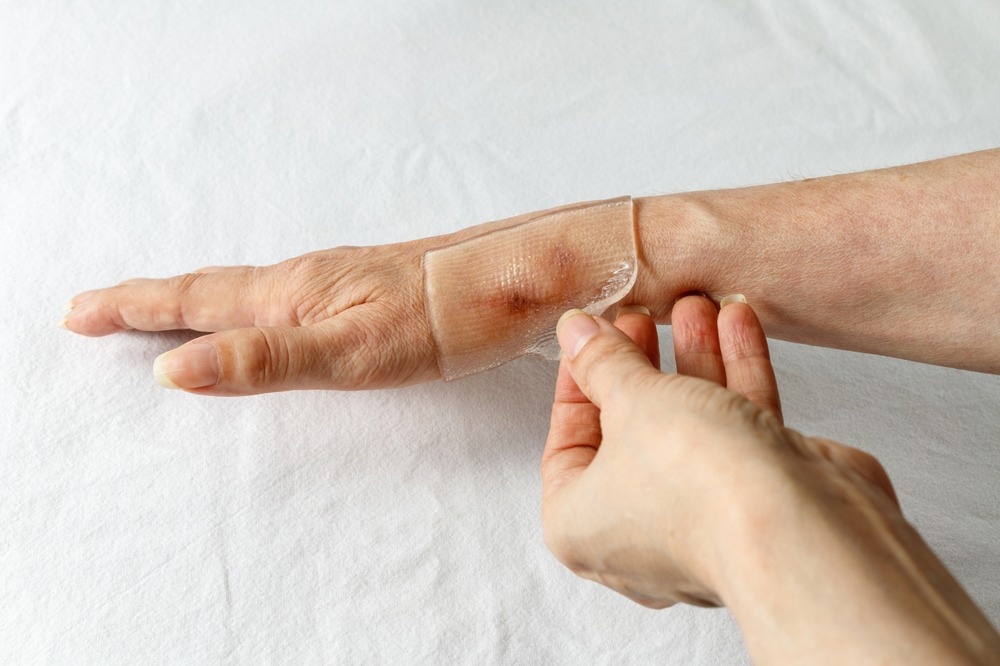 By Taha KhanReviewed by Lexie CornerJun 7 2024
By Taha KhanReviewed by Lexie CornerJun 7 2024Many traditional adhesives have limitations, such as harsh chemical compositions, difficulty controlling adhesion strength, and inability to function under diverse environmental conditions, leading to growing interest in bio-inspired adhesive technologies.1, 2

Image Credit: BartTa/Shutterstock.com
Studying natural adhesives found in organisms like geckos, mussels, and spiders can lead to innovative solutions with superior strength, flexibility, and reversibility compared to traditional adhesives.
Biological Inspirations and Technological Advances
Organisms like geckos, mussels, and spiders have unique natural adhesion abilities, which have inspired researchers to mimic them in adhesion-related applications.
Geckos Inspired Adhesives
Geckos can climb vertical walls and hang upside down due to the adhesiveness of millions of microscopic hairs on their feet called setae, which branch out into even smaller structures called spatulae.
These spatulae create a large surface area for contact, allowing geckos to utilize weak Van der Waals forces for strong adhesion on various surfaces. Scientists have translated this principle into microfabricated surfaces with similar features, resulting in adhesives with controllable adhesion strength.2, 3
For instance, in a 2008 study, researchers developed a novel medical adhesive inspired by gecko feet. They utilized a polymer called poly(glycerol-co-sebacate acrylate) (PGSA) and engineered its surface to replicate the nanostructures found on gecko feet, enabling strong attachment to surfaces.3
The adhesive's performance was optimized for medical applications by creating nanoscale pillars on the polymer surface and coating them with oxidized dextran. This combination significantly improved adhesion to wet tissues, as demonstrated in tests on porcine intestinal tissue and in vivo rat models.
This gecko-inspired adhesive has potential applications in wound sealing and as an alternative to traditional sutures and staples.3
Mussel Inspired Underwater Adhesives
Mussels secrete a cocktail of adhesive proteins with a key amino acid called DOPA (3,4-dihydroxyphenylalanine), allowing them to firmly attach themselves to rocks in the ocean under constant water pressure and waves. Researchers have successfully incorporated DOPA or its mimics into synthetic polymers, creating adhesives with exceptional underwater adhesion strength.4, 5
For example, in a 2021 study, researchers developed a novel bio-adhesive inspired by mussel proteins for medical applications under various pH levels and wet conditions. They created recombinant fusion proteins combining mussel foot proteins (Mfps) from Mytilus californianus and gas vesicle protein A (GvpA) from Anabaena flos-aquae via genetic engineering.5
These chimeric proteins are self-assembled into β-sheet-rich fibers, significantly enhancing adhesion, especially in alkaline environments. The study demonstrated that the copolymers of Mfp-5-GvpA and GvpA-Mfp-3 exhibit robust underwater adhesion, resilience to oxidation, and potential for diverse biomedical uses.5
Spider Silk Adhesive
Spiders produce multiple types of silk, each with unique properties and very high tensile strength and elasticity, allowing them to absorb energy without breaking. Scientists are focusing on synthetic bio-inspired fibers with similar properties for various applications.6,7
Researchers are also exploring the relationship between spider silk's unique mechanical properties and its glue's adhesive strength. For instance, in a 2018 study, researchers found that adhesive performance is not solely reliant on the glue droplets' stickiness but is also significantly influenced by the stiffness and strength of the silk fibers.7
Through peeling experiments and a theoretical model, the team demonstrated that optimal adhesion involves a synergistic relationship between the silk's mechanical properties and the glue's adhesive strength. This combination allows the silk to absorb energy effectively and maintain structural integrity, potentially leading to advanced biomimetic adhesives with very high adhesive strength.7
Applications and Benefits
Bio-inspired adhesive technologies have many potential applications across various industries. Compared to traditional options, these adhesives can be designed to be stronger, more versatile, biocompatible, and environmentally friendly.
In the medical field, researchers are developing surgical adhesives that mimic the strength and biocompatibility of mussel proteins. Similarly, gecko-inspired adhesives could revolutionize minimally invasive surgery by allowing stronger and more secure wound closure than traditional sutures and staples.3
The manufacturing sector can also benefit from bio-inspired adhesives like spider silk, which offer exceptional mechanical properties such as strength and elasticity. A 2020 study investigated the mechanical properties of piriform silk using nanoindentation and nanotensile techniques.
The findings revealed that piriform silk exhibits robust mechanical properties, which were effectively modeled to understand the composite mechanics of the silk. These findings could lead to advanced bio-inspired adhesives and fabrics mimicking spider silk's strong and durable properties for use in manufacturing.8
Challenges and Future Outlooks
Several challenges in the development and commercialization of bio-inspired adhesives need addressing. For instance, although it is feasible to create small quantities of bio-inspired adhesives in the lab, producing them on an industrial scale requires significant investment and technological innovation.
Replicating the complex structures and intricate chemistries found in nature can be challenging and may require novel methods and manufacturing techniques to create micro and nanostructures with the necessary precision. Continuous research and development are imperative to overcome these limitations.
Researchers can explore 3D printing and other advanced fabrication techniques to create biomimetic structures with greater accuracy and efficiency.1, 9 Moreover, combining bio-inspired adhesives with other functional materials to create intelligent adhesives that can respond to their environment or external stimuli could be the next step toward the future of bio-inspired adhesive technologies.
More from AZoM: Harnessing Microfluidic Technology for Heavy Metal Analysis
References and Further Reading
- Creton, C., Papon, E. (2003). Materials science of adhesives: How to bond things together. MRS Bulletin. doi.org/10.1557/mrs2003.121
- Linghu, C., et al. (2024). Fibrillar adhesives with unprecedented adhesion strength, switchability and scalability. National Science Review. doi.org/10.1093/nsr/nwae106
- Mahdavi, A., et al. (2008). A biodegradable and biocompatible gecko-inspired tissue adhesive. Proceedings of the National Academy of Sciences. doi.org/10.1073/pnas.0712117105
- Pandey, N., Soto-Garcia, LF., Liao, J., Zimmern, P., Nguyen, KT., Hong, Y. (2020). Mussel-inspired bioadhesives in healthcare: design parameters, current trends, and future perspectives. Biomaterials science. doi.org/10.1039%2Fc9bm01848d
- Iranpour, H., et al. (2021). Self-assembling of chimeric mussel-inspired bio-adhesives originated from Mytilus californianus and Anabaena flos-aquae: a new approach to develop underwater adhesion. International Journal of Adhesion and Adhesives. doi.org/10.1016/j.ijadhadh.2021.102938
- Lutz, TM., Kimna, C., Casini, A., Lieleg, O. (2022). Bio-based and bio-inspired adhesives from animals and plants for biomedical applications. Materials Today Bio. doi.org/10.1016/j.mtbio.2022.100203
- Guo, Y., et al. (2018). Synergistic adhesion mechanisms of spider capture silk. Journal of the Royal Society Interface. doi.org/10.1098/rsif.2017.0894
- Greco, G., Wolff, JO., Pugno, NM. (2020). Strong and tough silk for resilient attachment discs: The mechanical properties of piriform silk in the spider Cupiennius salei (Keyserling, 1877). Frontiers in Materials. doi.org/10.3389/fmats.2020.00138
- Dayan, CB., Chun, S., Krishna‐Subbaiah, N., Drotlef, DM., Akolpoglu, MB., Sitti, M. (2021). 3D printing of elastomeric bioinspired complex adhesive microstructures. Advanced Materials. doi.org/10.1002/adma.202103826
Disclaimer: The views expressed here are those of the author expressed in their private capacity and do not necessarily represent the views of AZoM.com Limited T/A AZoNetwork the owner and operator of this website. This disclaimer forms part of the Terms and conditions of use of this website.